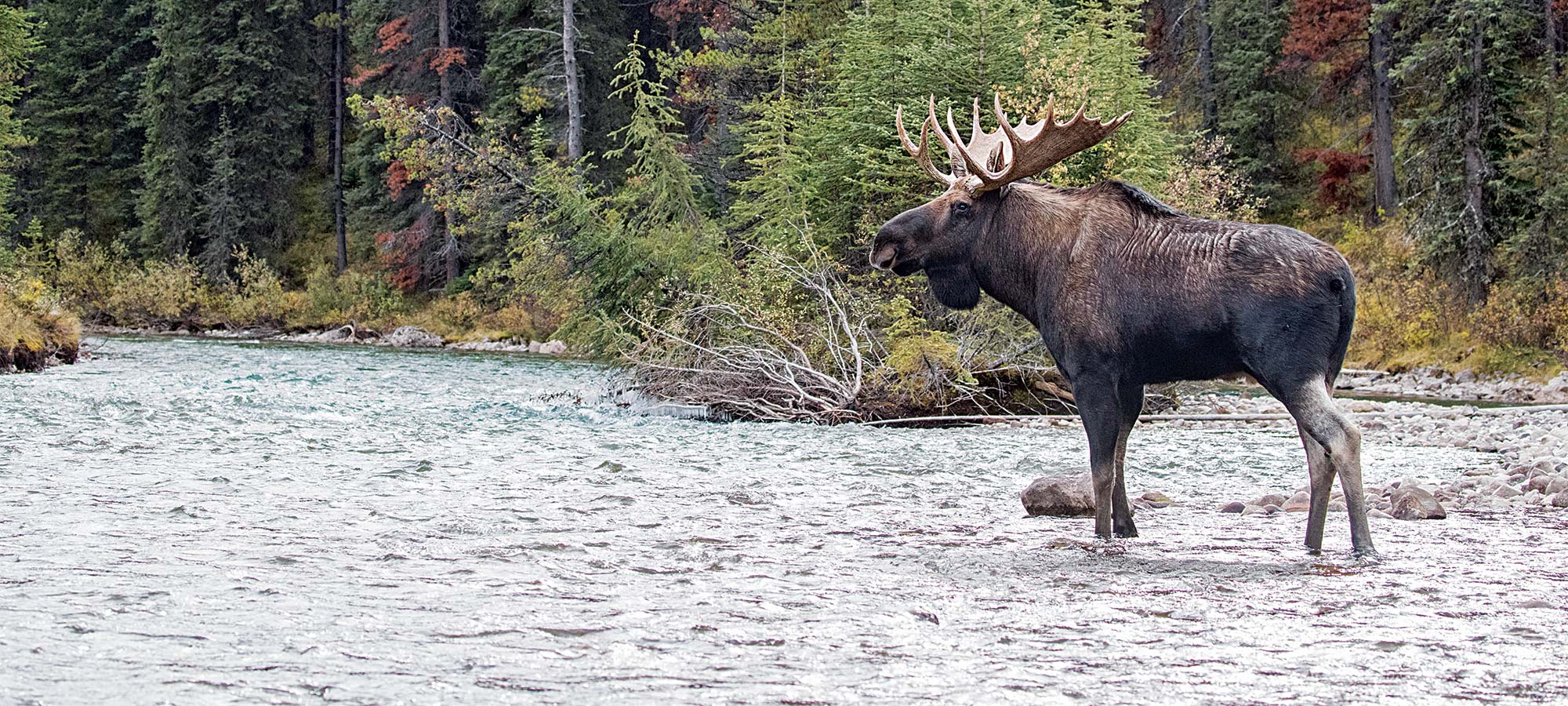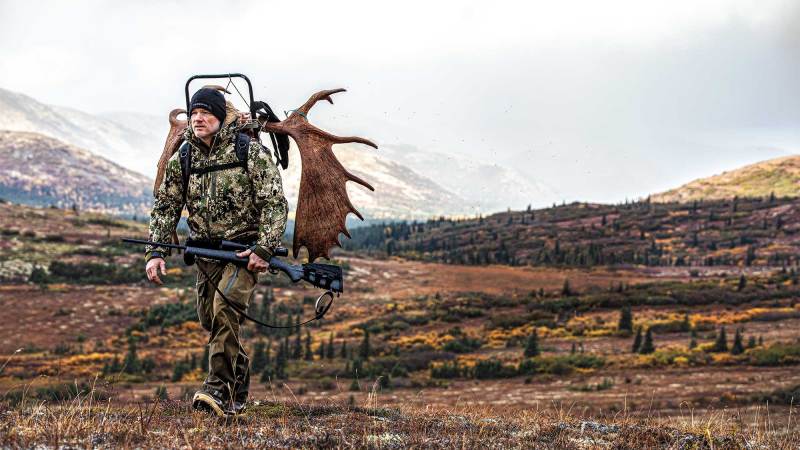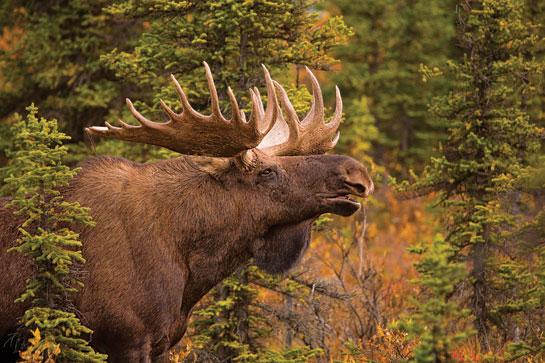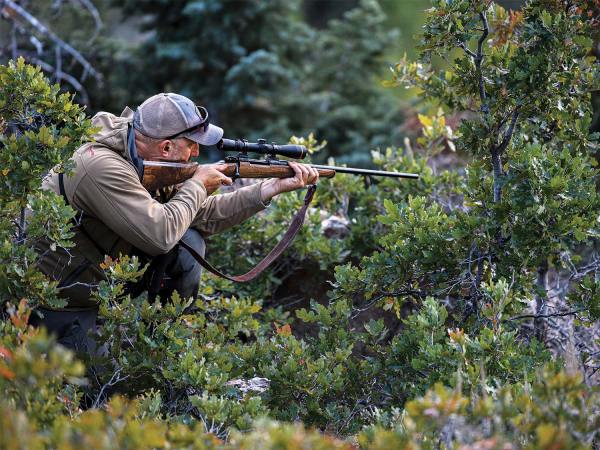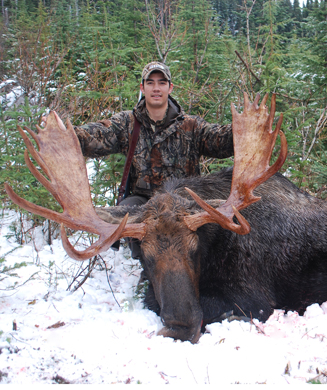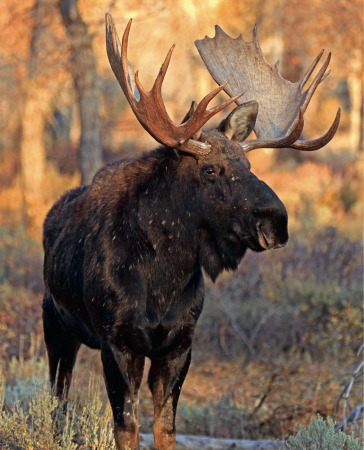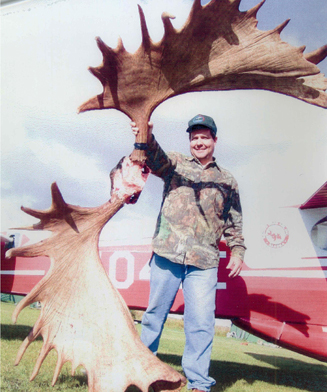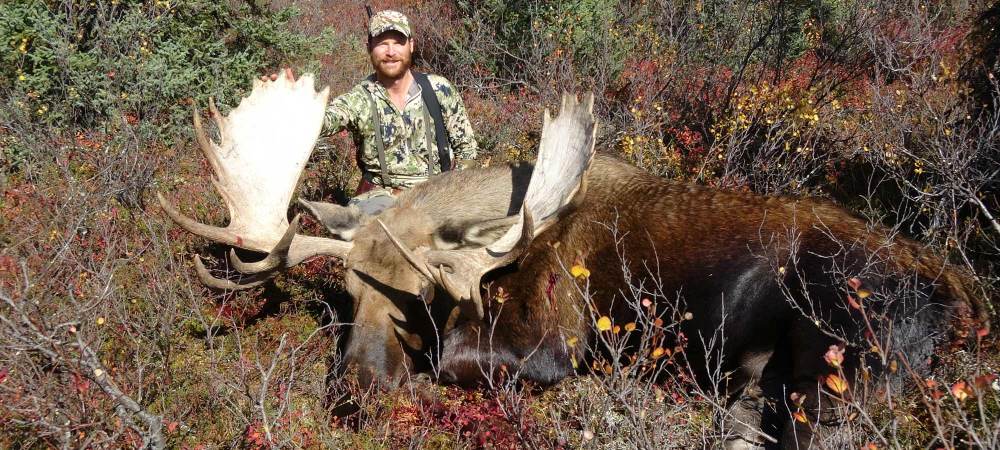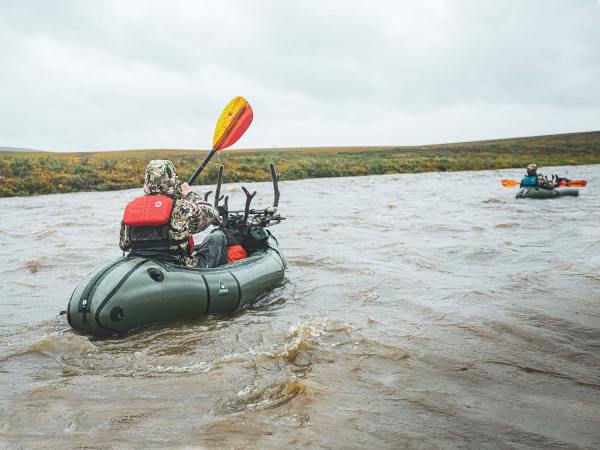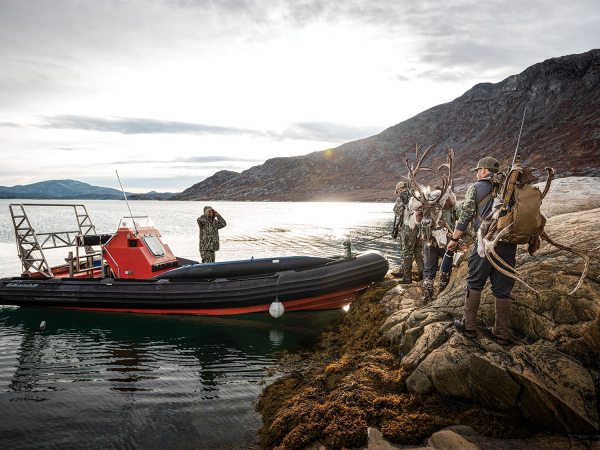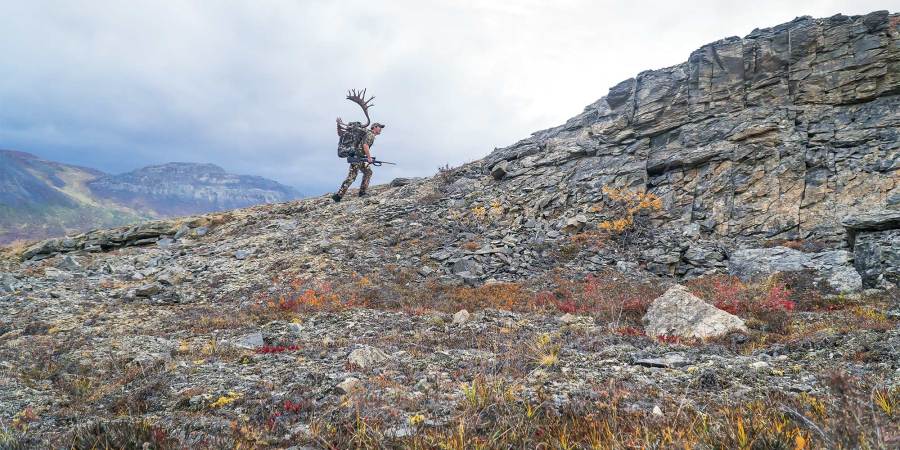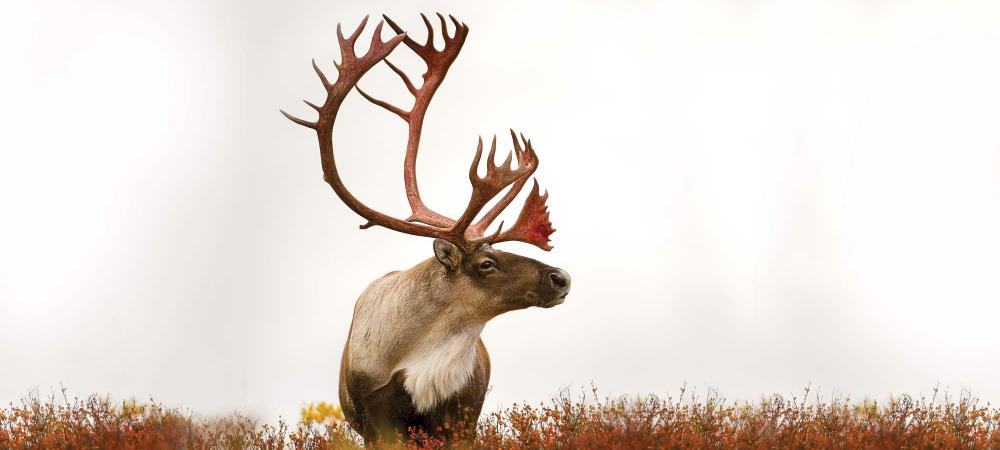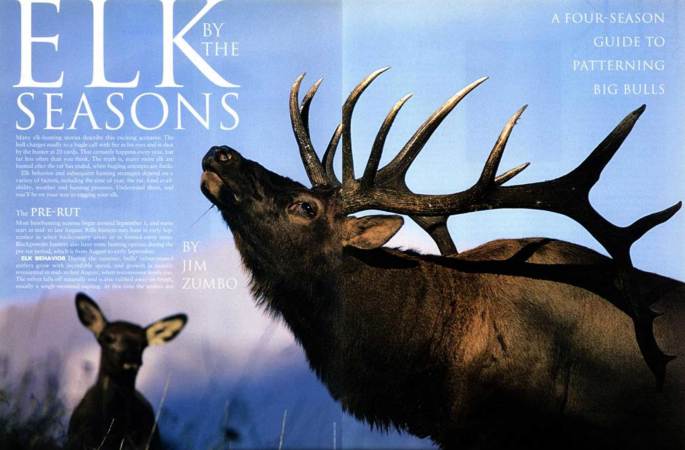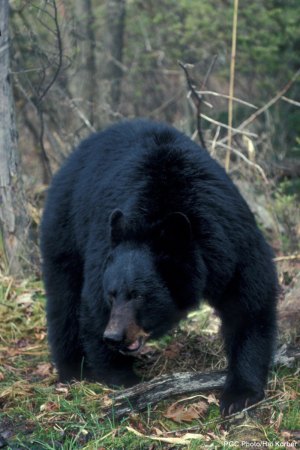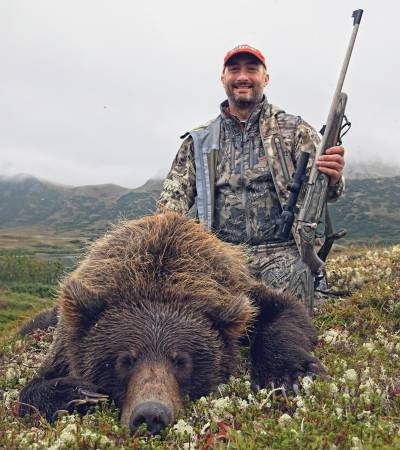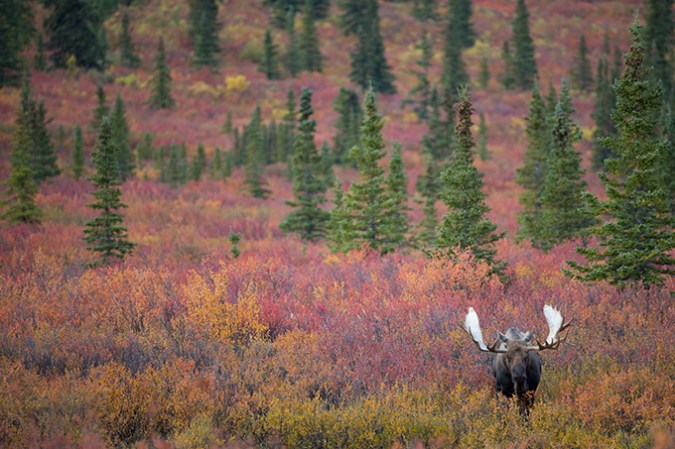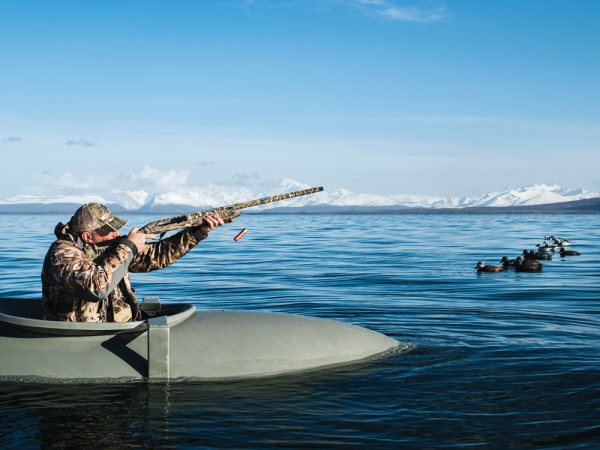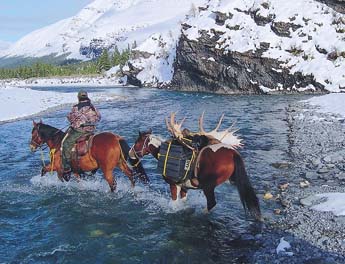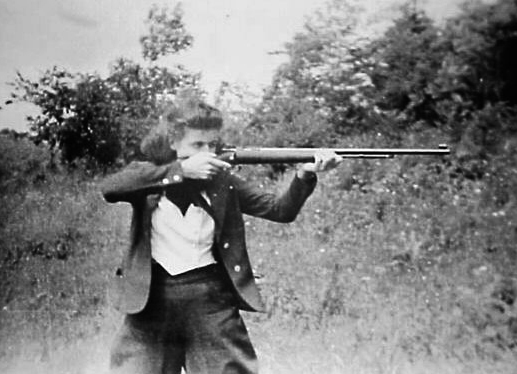They say the most dangerous thing to a moose is a second cup of coffee.” Marty Clark tightens the lid on his travel cup, takes a deep drink, and pulls the outboard motor to life. Our inflatable boat lurches forward, and we’re off again, trolling either our tenth or hundredth round of Toa Lake in British Columbia. I’ve lost count of our circuits over the days as we’ve puttered from one end of this lake to the other in search of big bull moose.
But Marty, regular as a metronome, is eternally optimistic that, despite all the evidence to the contrary, we’ll see a moose at any moment. He’s been that way all week, certain that a charcoal-black bull is just a minute, or another cup of coffee, in our future.
I turn to Linda Powell, sitting behind me in the boat, and she rolls her eyes. Linda and I are co-conspirators and fellow hostages on this little raft where we’ve spent our days and in the one-room trapper’s cabin where we’ve spent the last eight nights. We have another four days to go before we can head home, and both of us are pretty sure we’ll make the long trip south without a moose, let alone a pair of them. In some ways, we’d be happy to make the trade, our freedom for unfilled tags.
It’s been that kind of a week, despite or maybe because of Marty’s buoyancy. I have no doubt that he has guided previous clients to big bulls, but all I know for sure of his authority on moose are his North Woods bromides, which he tosses off a couple of times every day:
“Moose show up on their time, not ours.”
“Sometimes you just trip into one right off the hop. Sometimes you don’t.”
“The difference between a great moose guide and a lousy moose guide is five minutes.”
Once a bull responds to calling, it can take several minutes for him to show himself. Impatient hunters might move toward the bull, bumping him before they ever see him. But patient hunters are often rewarded when a curious bull emerges from cover in search of the sound of the calls. That’s why Marty says a second cup of coffee kills bulls. It seems as though he’ll take this approach and apply it to our full 12 days of hunting.
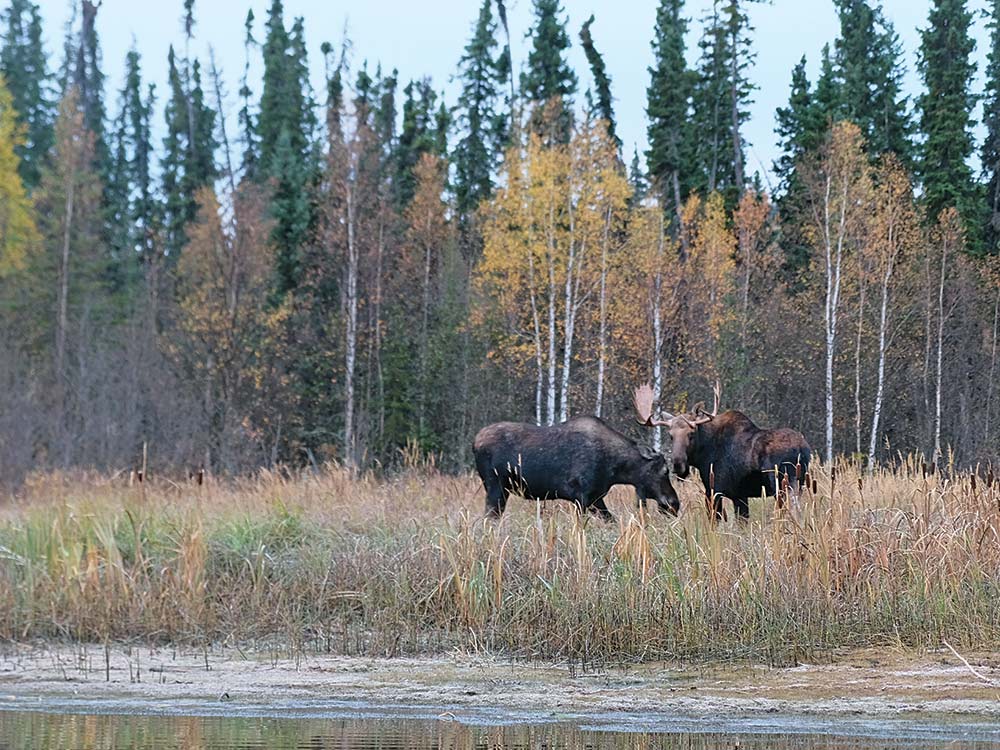
But it’s hard to damn Marty, as much as his platitudes grind. He’s cheerful and upbeat, and while I might privately wish for a dour, brooding guide to share our misery, I’m not sure Toa Lake can handle that much negativity. Because the truth of the matter is that we are playing a bad hand.
The hand is this: Toa Lake is ringed by about 10 miles of exposed shoreline. The lake’s muddy beach is maybe 30 feet deep, from the brackish water to the edge of the dense spruce forest that tumbles down from the low mountains surrounding the lake. That’s 1.5 million square feet of open ground. Or, converted to more familiar terms, that makes about 35 acres of visible shoreline. That’s it. That’s our hunting area, for two of us with bull tags and 12 days. Then there are the logistics of the thing. If we see a bull from a mile across the lake, we have limited time before he melts back into the timber.
Which is why we spend so much time glassing from this boat, a 14-foot inflatable V-hull with deep sides and a removable aluminum floor.
We toss out lines for pike and walleyes as we troll from one end of the lake to the other. The catching’s not red-hot, but it’s a nice diversion, and as the days slide by, we settle into a sullen pattern.
Every night we tuck into sleeping bags on side-by-side cots in the cabin, warmed by a wood stove, and snore ourselves to sleep. Every morning, we rise, boil water for instant coffee, yank on our hunting clothes, and climb into the boat. We putter through the reeds in the dark, kill the motor in the middle of the lake, and as we tie on fresh walleye jigs and watch the sun rise over the boreal wilderness, we listen. Our ears are listening for either the nasal bawl of a cow moose or the mewling bellow of a bull echoing in the forest. The plan, which in a week of trying hasn’t materialized, is to then row to the shore and call the bull onto the open shoreline, where we’ll kill him.
We actually came close on our third day. We spotted three black humps in the back of a reedy bay, and as the sun lit the lake, we could tell they were moose. Two had antlers—one was a little Bullwinkle in the company of a cow, which we assumed was his mother. The third was a mature bull. Marty cut the motor, and I knelt down in the bow of the boat and rested my rifle on the rubber skirt. As we rowed closer, Marty started making a racket. I looked back to see him splashing the water with one oar. Marty’s other hand was above his head, swinging the bone-white scapula of a moose back and forth. He was making guttural bawls, like someone dry-heaving into a garbage can.
Later he told me that bulls can’t discern distance, and they take the splashing and the boat to be another bull. Sometimes, they even charge. “It can get hairy, but I’ve never had a moose get into the boat,” Marty said with a smile. “Close. But not actually in.”
We got closer, and the bull, which didn’t seem to mind our raucous approach in the slightest, grew larger in my binocular. I was counting antler points.
In order to be a legal shooter in this part of British Columbia, a bull moose must have either three brow tines on an antler or at least 10 scorable points on one side. I could count only a pair of brow tines and eight, maybe nine points. Marty stopped rowing in order to glass the bull. Finally, he confirmed my count.
I relaxed and watched the show, the older bull trying to court the cow, the young bull stamping around bewilderedly. Finally, the trio melted into the forest, and we continued trolling the lake. The optimism sparked by this encounter dulled a little each day that we failed to see another moose.
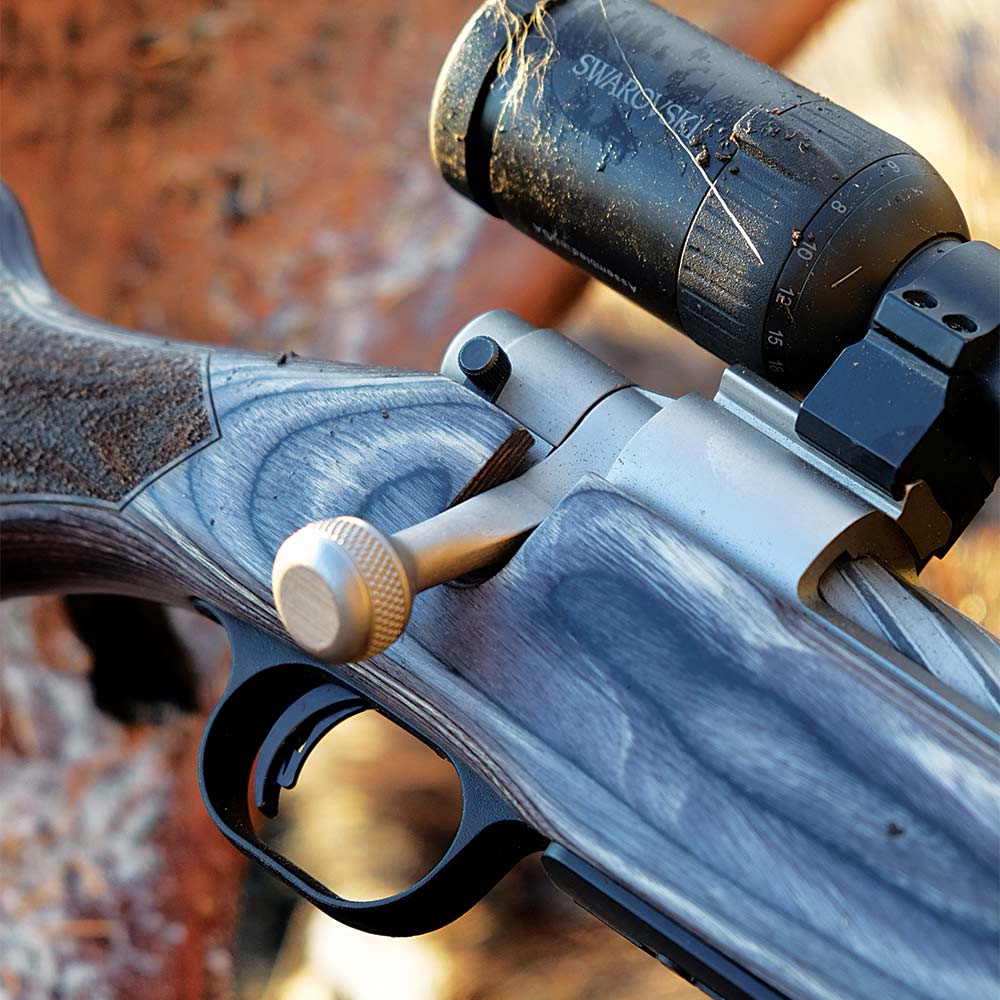
Bulls of Bust
Over the years, Linda (who runs media relations for Mossberg) and I have hunted together in lots of places for various animals, including bears, deer, elk, and turkeys. Despite eight previous hunts for them in places renowned for their moose hunting, Linda has never killed a big bull. Something always jinxed her. Either lousy weather or lazy guides or rogue horses prevented her from shooting a trophy bull. Once she had a bull standing broadside at 40 yards only to hear the click of a cartridge malfunction. She’s hunted Newfoundland for a combined 15 days without ever seeing a moose, while her hunting partners punched their tags. And she’s had weather conditions deteriorate so badly that a helicopter rescued her party from camp (this has actually happened to her twice).
But when she asked if I’d be interested in joining her in British Columbia, I jumped at the chance. My enthusiasm dimmed only slightly when she told me she had booked a 12-day hunt to better our chances.
Twelve days is a long time to hunt, but because I know how uncertain moose hunting can be, I accepted the terms. On my first moose hunt in British Columbia—a fly-in camp in the mountains north of Smithers—I stepped off the floatplane and onto the butchered carcass of a monster bull. The look on my guide’s face told me that was the moose we had flown there to hunt; we spent the next seven days searching in vain for a legal bull.
The only thing worse than the aimless wandering through frozen mud on that hunt was my guide’s mental state. Before we flew out of Smithers, his wife had given him a box and told him to open it at camp. Inside was a divorce decree and a bottle of whiskey. He didn’t share the bottle, but he did share the full range of his emotions. His bawling failed to call in a bull.
After years of research, Linda found an outfitter that seemed to check the right boxes: big bulls, good success rates, no horses. Located in northeastern B.C., between the outposts of Fort St. John and Fort Nelson, Pink Mountain Outfitters hunts moose by boat on remote lakes, which the guides access from the Alaska Highway. Their concession is the desolate, boggy, buggy provincial parkland that’s roadless except for grown-over seismic lines that were cut through the bush 20 years ago by gas prospectors.
Lloyd Clark bought Pink Mountain Outfitters a decade ago, after retiring from the oil fields of Alberta. He wanted an operation that married his two great loves: hunting and working with his family. Lloyd and Dawn Clark’s three kids work as Pink Mountain hunting guides, and they approach moose hunting the way a roughneck might approach a balky gas well—with big tools and momentum. But about 10 miles down the first cutline, I’d have traded my ATV for the greenest packhorse in British Columbia. We had to winch machines together to muscle through the soupy muskeg. Our eight-wheeled Argo snapped a drive chain and had to be shoved out of the trail. Every possession we owned was shellacked in mud and frozen grit. We slid down steep grades to creek crossings that consisted of tippy, frost-slick birch logs teetering over dysentery quags. By the time Marty, Linda, and I slogged through 25 miles of muskeg and face-slapping birch branches to the trapper’s cabin on Toa Lake, I was thrilled to get off the ATVs and into the rubber boat.
When most of us dream of trophy-class Canadian moose, we picture handsome vistas and backlit bulls standing broadside in open clearings. The reality is that through most of their range, moose live in mucky bottoms, bogs, and beaver-dam fens. Moose are made for this terrain. Their splaying hooves keep them from sinking into the mud, and their long legs let them stride over blown-down trees and knee-high briers. Their coloration hides them anywhere there are shadows.
It’s hard for humans to travel through the morasses where the biggest bulls live, and impossible to move quietly. But during the October rut, bulls do the moving, and my hopes were high that they might pass through our outpost on Toa Lake.
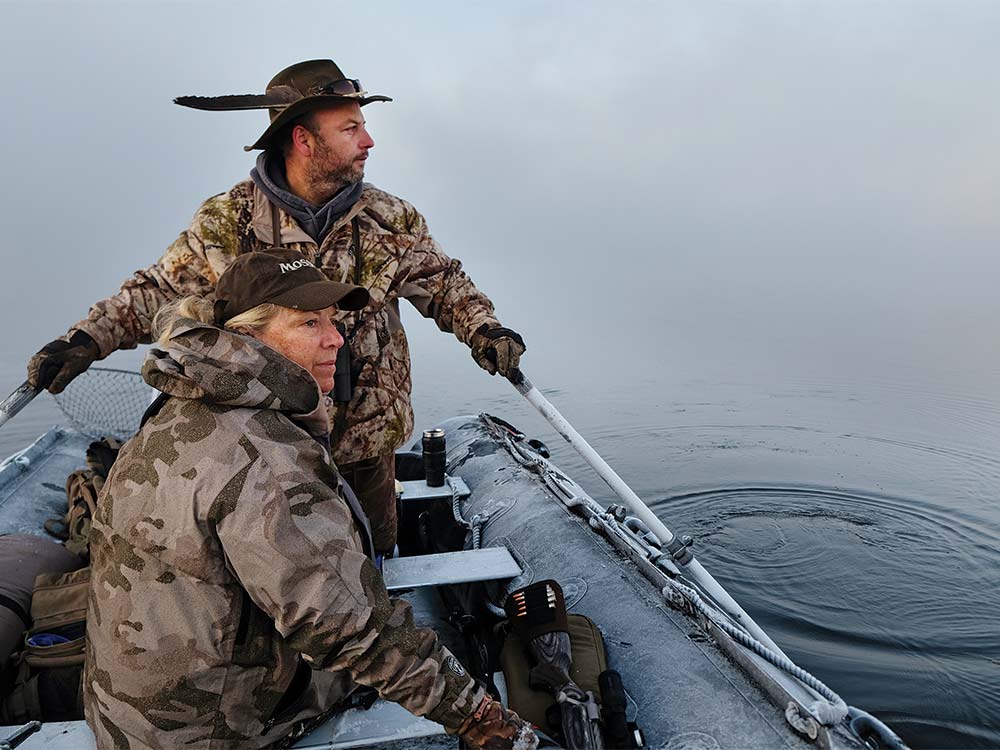
Moose at Last
On our ninth mooseless day, we woke to a hard frost and the first skim ice on the lake. As we rowed under pinkening skies to our listening station in the middle of the lake, loons wailed and tundra swans bugled reveille, mustering flocks to begin their southern migration.
“It’s a hunter’s morning,” I whispered to Linda. For some reason, none of us wanted to commence trolling that morning, so we sat silently on the still lake, soaking in the solitude. That’s when I saw him, a dark shape moving along the treeline of a distant bay. Then we spotted a flash of antler, and Marty began his splashy, bawling approach. I returned to the bow of the boat and studied him through my binocular, but this time my count was clear. He had four brow tines on his left side, and while his upper points were rounded off, I could count at least 10. I chambered a round in my .300 Win. Mag.
Read Next: How to Pack for an Alaskan Moose Hunt
The bull swaggered toward Marty’s calling, then walked along the shoreline, keeping a stand of reeds between the boat and himself. When we closed to within 50 yards, Marty turned me loose. It took three 180-grain Trophy Copper bullets, but the final shot erupted steam and water from his hide and toppled him over.
As we rowed to shore and walked up to the bull, Marty looked at me. “What did I tell you? All there is to moose guiding is five minutes and a little luck.”
That night, we celebrated finally tagging a moose, but our revelry was dampened by the realization that we didn’t have another nine days to devote to Linda’s bull. She didn’t say it, but I could tell she expected her ninth moose hunt to end much the way her earlier hunts had: with an intact tag.
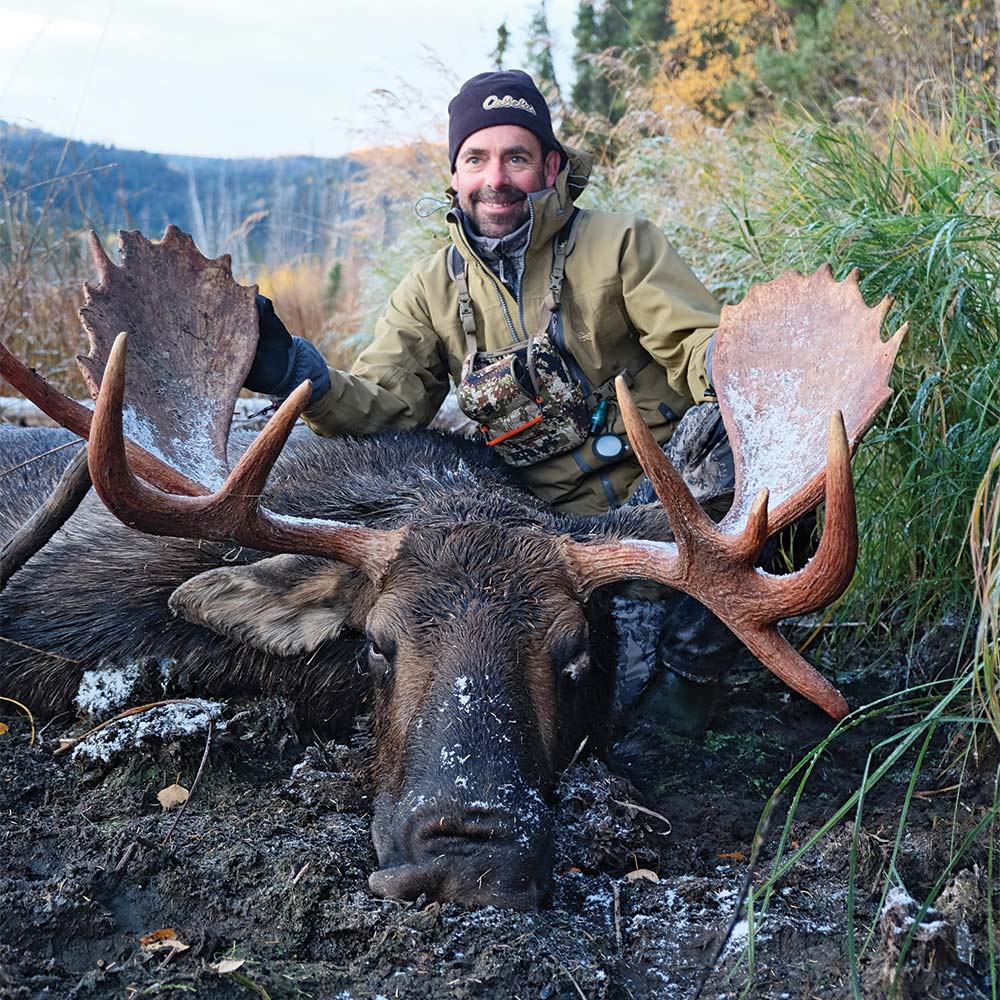
Despite our misgivings, it seemed that luck was now on our side. The afternoon of the next day, snow sifting into the basin, we spotted a big bull way across the lake. The image of that coal-black moose closing toward our calls, swimming the black bay in the blowing snow to cut the distance, is one that’s etched in my mind like scrollwork on a gunstock. His antlers were massive, and he tilted them from side to side as he approached.
Though I knew it was coming—it had been coming for a decade or more—the crack of Linda’s rifle still surprised me. The sight of a giant moose, staggering in the water before he went down, was equally surprising because it carried the realization that we had done it, killed two grand bulls in short order after days of numbing monotony.
The realization for Linda was even more cathartic because the weight of expectation had been building for so long. She broke down in the bow of the boat, sobbing in relief and gratitude as the snow squall passed and the sun broke through low clouds.
But Marty, unperturbed and upbeat as always, rowed toward the downed bull, wondering aloud how we’d get the massive carcass the 70 yards to solid shore in order to quarter him. “Every moose guide is happy to hear the sound of a gun,” he said. “But the fun ends when the shooting stops.”

